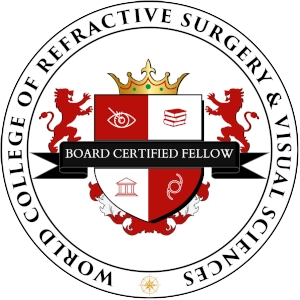Astigmatic Keratotomy
For the correction of high astigmatism
Astigmatism Correction at a Glance
- Often, nearsightedness and farsightedness are accompanied by a mild astigmatism.
- A mild astigmatism can be corrected with eyeglasses, contact lenses or eye laser procedures such as LASIK.
- Astigmatic keratotomy is used to reduce severe astigmatism of approximately 5 dpt or higher as they may occur after an ocular trauma or corneal transplant.
- Collagen cross linking can be used to stabilize a keratoconus.
What happens during the procedure?
For the procedure, an arch-shaped deep incision is placed in the axis of the strongest curvature on the periphery of the cornea.
At FreeVis, we use the femtosecond laser to precisely and accurately cut the corneal tissue. This incision relaxes the corneal tissue in the axis and results in a reduction of the curvature and thereby in a reduction of the astigmatism.
The astigmatic keratotomy is an outpatient procedure. Prior to surgery, you will be offered a relaxant. The eye is then anesthetized locally with eye drops so that you will not feel any discomfort during surgery. For the surgery, which only lasts a few minutes, your eye is fixated with light pressure by a special ring-shaped device. The procedure is painless.
Recovery after the surgery
After the surgery, the eye is covered with a clear bandage, which you may remove a few hours later. It is possible that a small foreign body sensation or slight discomfort may occur for a few hours following the procedure.
A reduction of the astigmatism can be observed as early as the day after surgery. However, it takes a few weeks until the result is stabilized. Usually, new eyeglasses have to be prescribed a few days after the surgery because the astigmatism has been reduced but not eliminated altogether. You will receive eye drops, which have to be applied for several days after surgery, and you will generally be able to resume work within a few days after the procedure.
What problems can occur?
After an astigmatic keratotomy, your vision without eyeglasses may initially get worse, especially in cases of a combination of farsightedness and astigmatism.
The vision you can achieve with eyeglasses will be better after the operation than before, because the astigmatism has been reduced. It is likely that a new prescription for eyeglasses will be required before operating a motor vehicle.
Good vision without eyeglasses will be achieved after a second procedure such as LASIK is performed.
Although severe side effects are not likely, they cannot be excluded completely. In some cases, an irregular astigmatism may occur. In extremely rare cases, a perforation of the eye may occur because the incision was placed too deep.
Treatment costs
The treatment costs for vision correction surgery are generally not reimbursed by the statutory health insurance. This also applies to the initial (pre-op) consultation and follow up exams after the procedure. The treatment is billed according to the doctor's fee schedule (GOÄ).
Please feel free to request the costs for the intitial examination and the surgical procedures here.






